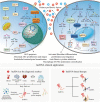Long non-coding RNAs: Promising new targets in pulmonary fibrosis
- PMID: 33533071
- PMCID: PMC7988597
- DOI: 10.1002/jgm.3318
Long non-coding RNAs: Promising new targets in pulmonary fibrosis
Abstract
Pulmonary fibrosis is characterized by progressive and irreversible scarring in the lungs with poor prognosis and treatment. It is caused by various factors, including environmental and occupational exposures, and some rheumatic immune diseases. Even the rapid global spread of the COVID-19 pandemic can also cause pulmonary fibrosis with a high probability. Functions attributed to long non-coding RNAs (lncRNAs) make them highly attractive diagnostic and therapeutic targets in fibroproliferative diseases. Therefore, an understanding of the specific mechanisms by which lncRNAs regulate pulmonary fibrotic pathogenesis is urgently needed to identify new possibilities for therapy. In this review, we focus on the molecular mechanisms and implications of lncRNAs targeted protein-coding and non-coding genes during pulmonary fibrogenesis, and systematically analyze the communication of lncRNAs with various types of RNAs, including microRNA, circular RNA and mRNA. Finally, we propose the potential approach of lncRNA-based diagnosis and therapy for pulmonary fibrosis. We hope that understanding these interactions between protein-coding and non-coding genes will contribute to the development of lncRNA-based clinical applications for pulmonary fibrosis.
Keywords: COVID-19; circular RNA; lncRNA; microRNA; pulmonary fibrosis.
© 2021 The Authors. The Journal of Gene Medicine published by John Wiley & Sons Ltd.
Conflict of interest statement
The authors declare that they have no conflicts of interest.
Figures


Similar articles
-
Integrated long non-coding RNA analyses identify novel regulators of epithelial-mesenchymal transition in the mouse model of pulmonary fibrosis.J Cell Mol Med. 2016 Jul;20(7):1234-46. doi: 10.1111/jcmm.12783. Epub 2016 Jan 29. J Cell Mol Med. 2016. PMID: 26824344 Free PMC article.
-
Non-coding RNA alterations in extracellular vesicles from bronchoalveolar lavage fluid contribute to mechanical ventilation-induced pulmonary fibrosis.Front Immunol. 2023 Mar 13;14:1141761. doi: 10.3389/fimmu.2023.1141761. eCollection 2023. Front Immunol. 2023. PMID: 36993978 Free PMC article.
-
New advances of lncRNAs in liver fibrosis, with specific focus on lncRNA-miRNA interactions.J Cell Physiol. 2019 Mar;234(3):2194-2203. doi: 10.1002/jcp.27069. Epub 2018 Sep 19. J Cell Physiol. 2019. PMID: 30229908 Review.
-
Profiling long non-coding RNA changes in silica-induced pulmonary fibrosis in rat.Toxicol Lett. 2019 Aug;310:7-13. doi: 10.1016/j.toxlet.2019.04.003. Epub 2019 Apr 9. Toxicol Lett. 2019. PMID: 30978436
-
Non-coding RNA Associated Competitive Endogenous RNA Regulatory Network: Novel Therapeutic Approach in Liver Fibrosis.Curr Gene Ther. 2019;19(5):305-317. doi: 10.2174/1566523219666191107113046. Curr Gene Ther. 2019. PMID: 31696817 Review.
Cited by
-
ATF3 -activated accelerating effect of LINC00941/lncIAPF on fibroblast-to-myofibroblast differentiation by blocking autophagy depending on ELAVL1/HuR in pulmonary fibrosis.Autophagy. 2022 Nov;18(11):2636-2655. doi: 10.1080/15548627.2022.2046448. Epub 2022 Apr 15. Autophagy. 2022. PMID: 35427207 Free PMC article.
-
LINC01305 recruits basonuclin 1 to act on G-protein pathway suppressor 1 to promote esophageal squamous cell carcinoma.Cancer Sci. 2023 Nov;114(11):4314-4328. doi: 10.1111/cas.15963. Epub 2023 Sep 13. Cancer Sci. 2023. PMID: 37705202 Free PMC article.
-
STAT3 Facilitates Super Enhancer Formation to Promote Fibroblast-To-Myofibroblast Differentiation by the Analysis of ATAC-Seq, RNA-Seq and ChIP-Seq.J Cell Mol Med. 2025 Jun;29(11):e70639. doi: 10.1111/jcmm.70639. J Cell Mol Med. 2025. PMID: 40464702 Free PMC article. Review.
-
MOBT Alleviates Pulmonary Fibrosis through an lncITPF-hnRNP-l-Complex-Mediated Signaling Pathway.Molecules. 2022 Aug 22;27(16):5336. doi: 10.3390/molecules27165336. Molecules. 2022. PMID: 36014574 Free PMC article.
-
miRNA, lncRNA and circRNA: targeted molecules with therapeutic promises in Mycoplasma pneumoniae infection.Arch Microbiol. 2023 Jul 21;205(8):293. doi: 10.1007/s00203-023-03636-3. Arch Microbiol. 2023. PMID: 37477725 Review.
References
-
- Lampi MC, Reinhart‐King CA. Targeting extracellular matrix stiffness to attenuate disease: from molecular mechanisms to clinical trials. Sci Transl Med. 2018;10:422–435. - PubMed
-
- Mora AL, Rojas M, Pardo A, Selman M. Emerging therapies for idiopathic pulmonary fibrosis, a progressive age‐related disease. Nat Rev Drug Discov. 2017;16:755‐772. - PubMed
-
- Ooi GC, Khong PL, Müller NL, et al. Severe acute respiratory syndrome: temporal lung changes at thin‐section CT in 30 patients. Radiology. 2004;230:836‐844. - PubMed
Publication types
MeSH terms
Substances
Grants and funding
LinkOut - more resources
Full Text Sources
Other Literature Sources
Medical

